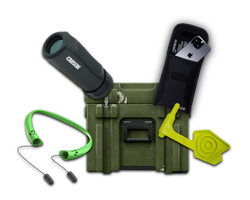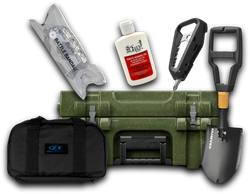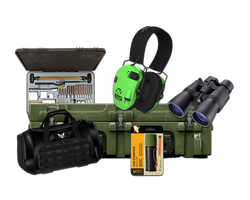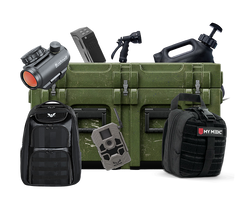How Do Sniper Scopes Work? Understanding the Mechanics Behind Precision Shooting
Table of Contents
- Introduction
- The Basics of Sniper Scopes
- Understanding Bullet Trajectory
- Adjustments for Long-Range Shooting
- Advanced Features in Sniper Scopes
- Real-World Application: Sniper Teams
- Summary
- FAQ
Introduction
Have you ever wondered how snipers consistently hit targets from hundreds, if not thousands, of yards away? The secret lies in their equipment, particularly the sniper scope. These sophisticated devices not only magnify distant images but also provide critical adjustments for factors like bullet drop and windage. As technology has advanced, so too have the capabilities of sniper scopes, making them indispensable tools for precision shooting.
In this post, we'll delve deep into the mechanics of sniper scopes, exploring how they function, the adjustments snipers must make, and the various features that enhance their shooting accuracy. By the end, you will have a comprehensive understanding of the intricacies involved in using sniper scopes and what makes them a vital component of a sniper's arsenal.
Historical Context
The evolution of sniper scopes can be traced back to the early days of firearms. Initially, marksmen relied on iron sights, which provided limited accuracy at long distances. As warfare technology progressed, the need for greater precision became apparent. The introduction of optical sights revolutionized shooting, allowing marksmen to engage targets at unprecedented ranges. Today, modern sniper scopes incorporate advanced optics and electronics, making them more effective than ever.
This exploration serves not only to inform but also to enhance your appreciation for the skill and technology involved in long-range shooting. Whether you're a seasoned shooter or a curious novice, understanding how sniper scopes work will empower you in your pursuit of excellence.
The Basics of Sniper Scopes
What is a Sniper Scope?
At its core, a sniper scope is an optical device mounted on a rifle that enhances a shooter's ability to aim accurately at distant targets. It does this through a combination of magnification and reticle (crosshair) design, which assist in targeting and adjusting for various environmental factors.
Components of a Sniper Scope
- Objective Lens: This is the front lens of the scope that gathers light and focuses it to create a clear image of the target.
- Ocular Lens: Located at the rear, this lens magnifies the image created by the objective lens, allowing the shooter to see the target more clearly.
- Reticle: The crosshair or aiming point within the scope. Different reticle designs help shooters estimate range and adjust for bullet drop and windage.
- Turrets: Knobs located on the top and side of the scope that allow for adjustments in elevation (up and down) and windage (left and right).
- Tube: The main body of the scope, typically made of aluminum or other durable materials, which houses the lenses and adjustment mechanisms.
How Do Sniper Scopes Magnify Images?
Magnification is one of the primary functions of a sniper scope. The relationship between the objective lens, ocular lens, and the distance to the target determines how effectively the scope can magnify distant images. Most sniper scopes offer variable magnification, allowing shooters to adjust the level of zoom based on their specific needs and the distance to the target. This is crucial for identifying targets and making precise shots.
Understanding Bullet Trajectory
The Physics Behind Shooting
When a bullet is fired, it does not travel in a straight line. Instead, it follows a parabolic arc due to the influence of gravity. This means that over longer distances, a bullet will drop, requiring the shooter to make adjustments to their aim.
To illustrate, consider the following factors that affect bullet trajectory:
- Gravity: All projectiles, including bullets, are subject to gravitational pull, causing them to drop as they travel.
- Air Resistance: As a bullet moves through the air, it encounters drag, which can affect its speed and trajectory.
- Wind: Wind can push a bullet off course, requiring adjustments to compensate for lateral drift.
Zeroing the Scope
Before a sniper can effectively use their scope, it must be zeroed, meaning that the point of aim (the reticle) is aligned with the point of impact (where the bullet strikes). This is typically done at a known distance, commonly 100 yards. To zero a scope, a shooter will fire several shots at a target and make adjustments to the turrets until the point of impact matches the reticle.
Adjustments for Long-Range Shooting
Elevation and Windage
Once the scope is zeroed, adjustments must be made based on the distance to the target and environmental conditions:
- Elevation Adjustments: As the distance to the target increases, the bullet will drop more. Shooters adjust the elevation turret to raise the reticle, compensating for the bullet's drop at that distance.
- Windage Adjustments: Wind can significantly affect a bullet's path. Shooters use the windage turret to adjust their aim left or right based on the wind's speed and direction.
Calculating Adjustments
Snipers often use a combination of experience, ballistic charts, and specialized tools to determine the necessary adjustments for distance, wind speed, and other factors. The use of a ballistic calculator can greatly enhance precision by taking into account variables such as bullet type, weight, and atmospheric conditions.
Advanced Features in Sniper Scopes
Reticle Design
Modern sniper scopes feature various reticle designs that assist in range estimation and adjustments. Some popular designs include:
- Mil-Dot Reticles: These reticles have dots spaced evenly along the crosshairs, allowing shooters to estimate range and make precise adjustments based on known measurements.
- BDC (Bullet Drop Compensation) Reticles: These reticles are designed with markings that correspond to specific distances, allowing shooters to aim without making adjustments for known ranges.
Parallax Adjustment
Parallax occurs when the reticle appears to move relative to the target due to misalignment between the shooter’s eye and the scope. Many sniper scopes feature a parallax adjustment knob that allows the shooter to eliminate this issue at various distances, ensuring the reticle aligns perfectly with the target.
Night Vision and Thermal Imaging
Some advanced sniper scopes come equipped with night vision or thermal imaging capabilities. These features allow for effective targeting in low-light conditions, enhancing a sniper's effectiveness during nighttime operations.
Real-World Application: Sniper Teams
The Role of the Spotter
In a sniper team, the sniper and the spotter work in tandem to achieve accuracy. The spotter plays a critical role in:
- Target Identification: The spotter uses a separate scope to locate and confirm targets.
- Distance and Wind Calculations: The spotter uses tools like rangefinders and ballistic calculators to provide the shooter with crucial data.
- Call Corrections: After each shot, the spotter observes the impact and communicates any necessary adjustments to the shooter.
This collaborative approach significantly increases the likelihood of a successful engagement.
Summary
Understanding how sniper scopes work is essential for anyone interested in long-range shooting. These sophisticated devices combine advanced optics with precise adjustments to enable shooters to hit targets at extreme distances. From the mechanics of magnification to the nuances of bullet trajectory, the intricacies of sniper scopes reflect a blend of technology and skill.
Whether you are a tactical enthusiast, a beginner, or simply curious about firearms, this post has equipped you with valuable insights into the world of sniper scopes. If you're looking to enhance your own shooting experience, consider exploring Crate Club's subscription services, where you can receive high-quality tactical gear, including sniper scopes and other essential equipment.
Explore Crate Club's offerings today:
- Crate Club Subscription Services: Subscribe Here
- Crate Club Shop: Shop Now
FAQ
How do I zero my sniper scope?
To zero your sniper scope, set up at a known distance (usually 100 yards), fire a group of shots, and then adjust the turrets until the point of impact matches the reticle.
What factors should I consider when adjusting for wind?
When adjusting for wind, consider the wind speed, direction, and distance to the target. Using a wind meter can help you gauge this accurately.
Can I use a sniper scope for hunting?
Yes, many hunters use sniper scopes for increased accuracy, especially for long-range shots. However, make sure to check local regulations regarding scope use for hunting.
What is the difference between a tactical and hunting scope?
Tactical scopes often include features like illuminated reticles and quick adjustments for various distances, while hunting scopes may prioritize lightweight design and durability.
Do all sniper scopes have parallax adjustment?
Not all sniper scopes have parallax adjustment, but many high-quality models do. It's an important feature for ensuring accuracy, especially at longer distances.
By understanding the mechanics behind sniper scopes, you can appreciate the skill involved in precision shooting and the technology that supports it. Whether you're aiming for accuracy in the field or simply looking to enhance your shooting knowledge, mastering the use of sniper scopes is a valuable pursuit.
Share this article



